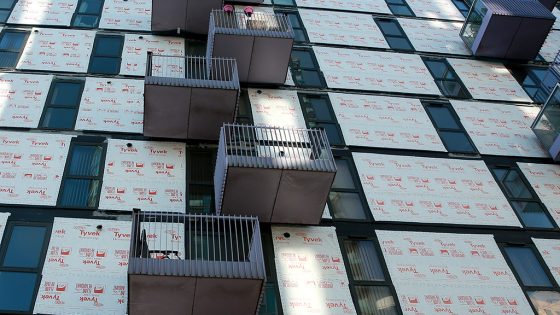Stalling developers, building safety regulator issues and squeezed social landlord finances mean the government is on track to miss its 2035 target for remediating dangerous cladding, according to a spending watchdog.
A report by the National Audit Office (NAO) said work to remove the most dangerous aluminium composite material cladding from buildings over 18 metres was almost complete.
But only up to 60 per cent of the estimated 12,000 buildings over 11 metres needing remediation had been identified by the government, it added.
The NAO warned: “Based on its latest modelling, MHCLG [the Ministry for Housing, Communities and Local Government] estimates that remediation of buildings over 11 metres with unsafe cladding will complete by 2035. Remediation is not currently on course to achieve this.”
It said that even based on the MHCLG’s own model, remediation of some buildings may not complete until 2036/37.
The ministry did not expect high volumes of new high-rise buildings to be identified, the NAO said, but it was taking longer than expected to bring medium-rise buildings – between 11 and 18 metres tall – into the programme.
It said that building owners responsible for fixing issues with cladding were failing to come forward in the numbers expected.
“[MHCLG] understands that some building owners may be reluctant to engage for fear of uncovering problems that are out-of-scope for government funding, and that others – such as Right to Manage companies – can lack the time and knowledge to navigate the process,” the report noted.
In addition, for buildings where developers were paying for remediation works, “protracted discussions between freeholders and developers over the scope of works can delay works”.
The NAO also identified delays associated with the creation of the new Building Safety Regulator (BSR), which must approve remediation works on buildings above 18 metres.
It said that problems with the quality of applications to the BSR were “impacting the number of starts on site”.
Meanwhile, “high threshold criteria” for government funding of full remediation costs incurred by social housing providers were also causing problems.
The NAO said: “Providers may be reluctant to apply to MHCLG for full remediation funding due to the perceived wider regulatory repercussions of declaring the levels of financial unviability required to qualify for funds.”
The slow pace of remediation has also impacted MHCLG’s budget and expenditure. As of August 2024, £2.3bn had been spent on remediation, with the Building Safety Fund (BSF) accounting for 77 per cent of the total. However, spending remained below expectations, and “by March 2024, was over £1bn behind initial expectations of £3.4bn.”
To accelerate progress, MHCLG is now exploring technological interventions, including artificial intelligence, to help locate buildings that may not yet be in any programme and identify those with unsafe cladding.
However, the NAO warned that there remained “a risk that some may never be identified.”
In September, responding to the phase two report of the Grenfell Tower Inquiry, prime minister Keir Starmer pledged to bring forward measures to speed up remediation of buildings with dangerous cladding.
Last week, chancellor Rachel Reeves used her Budget speech to announce more than £1bn for cladding remediation.
Construction News reported on Friday (1 November) that the House of Commons Public Accounts Committee is to investigate the government’s progress on high-rise remediation.

